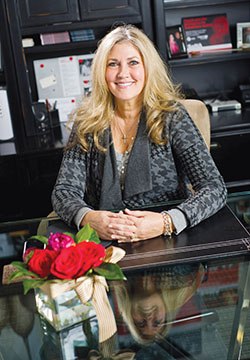SoNA: From Survival to Spectacular
by November 25, 2013 12:00 am 243 views

Much has been said about the Symphony of Northwest Arkansas. The old orchestra under an old name grew frail and nearly died, but was rescued in the final movement by the power of music itself. New leaders were gathered, finances were settled and then came the arrival of a maestro with a credentialed baton.
All of that’s true, and it’s also in the past.
Five years after the orchestra nearly took its last breath, SoNA, as it’s known these days, is the picture of health — powerful strings, rumbling timpani, precision brass, and on some occasions, the hallelujah of a full-throated choir known as the SoNA Singers.
Now in its third season of the renaissance, SoNA reconfirmed its quality on Nov. 16 with Barber’s haunting “Adagio for Strings,” a spirited treatment of Beethoven’s “Emperor Concerto,” with pianist Simon Mulligan, and Schubert’s towering “Symphony No. 9.”
SoNA is confident in the presence of the most important works in the classical canon, and when the violinists are pulling at their bows and when the trumpets are calling, the orchestra’s sound is unmistakably big. And plenty of people have taken notice. SoNA has five straight sellouts under its belt, and since season one has landed grants, cultivated its roster of donors, started an endowment and has mounted an educational program.
Rebuilding the symphony has taken countless hours, enough brain wattage to light a town, and, of course, hundreds of thousands of dollars.
At the center of this effort is SoNA’s Jack-of-all-trades executive director, Karen Kapella, who with a mix of grit and glamor has helped restore and redefine the orchestra’s most valuable asset — its credibility.
And if it’s true that Kapella has a tight hold on the symphony’s reigns, it’s also true that her grip won’t loosen anytime soon.
“I never think we’ve got this in the bag,” Kapella said. “We can never sit back and relax.”
She’s right. With dozens of musicians and a long list of production costs, professional orchestras are cumbersome and expensive to maintain. Just ask around in Nashville, Minneapolis, Philadelphia and Louisville, where recent or ongoing financial problems have plagued symphonies.
But SoNA has a trump card, and his name is Paul Haas.
As the symphony’s music director, he has an enormous say in what SoNA does and what it is. He’s responsible for selecting personnel for the standing orchestra, through open blind auditions, as well as for those who sit in as guests. And in the fulfillment of those key duties, it doesn’t hurt that he lives in New York, a city filled with symphonic music.
“He’s metropolitan,” Kapella said of Haas. “He’s connected to art and he’s surrounded by it. He’s wired into these musicians and has a high taste level.”
In addition to molding the permanent symphony, Haas has brought in talent from around the world — violinist Liana Gourdjia, cellist Sebastian Baverstam, pianist Ching-Yun Hu, and bass-baritone vocalist Charles Perry Sprawls, among others.
It’s all added up to standing ovations, increased ticket sales and an air of excitement surrounding SoNA.
“You’ve got to have a great artistic product,” Kapella said. “That’s what drives donations. That’s what drives support.”
Since 2008, when the old symphony crashed, the orchestra’s revenue has grown by a staggering 443 percent, from -$161,000 to $552,144 in fiscal 2013. From fiscal 2011 to this year, the budget has grown by 257 percent, from $182,000 to $650,000 — and SoNA is in the black.
“We look at every penny and don’t waste a cent,” Kapella said. “We’re in tip-top shape.”
Highlights of the financial turnaround include a grant from the Walton Family Foundation in the amount of $411,000, with disbursements in fiscal 2014, 2015 and 2016. While $326,000 is earmarked for general operations, another $85,000, issued on a one-for-one matching basis for a potential total of $170,000, is for educational programming for underserved elementary students in Northwest Arkansas.
The Windgate Charitable Foundation and the Walmart Foundation are also contributors to the program, set to begin this spring and headed by flutist and education director Kristen Predl.
Perhaps it would be easy to look back on all that’s been done and breathe a sigh of relief. Artistically, the orchestra is strong. The finances are good. The list of the symphony’s supporters reads like a Who’s Who of Northwest Arkansas. The education program is about to start and on the horizon is the renovation and expansion of SoNA’s home base, the Walton Arts Center.
But for Kapella that’s just the beginning. She’s got her eye on the biggest of all prizes, the endowment, which could spell financial health for SoNA for years to come.
“We’re hoping and planning and striving for a major gift,” she said. “The sky’s the limit.”
